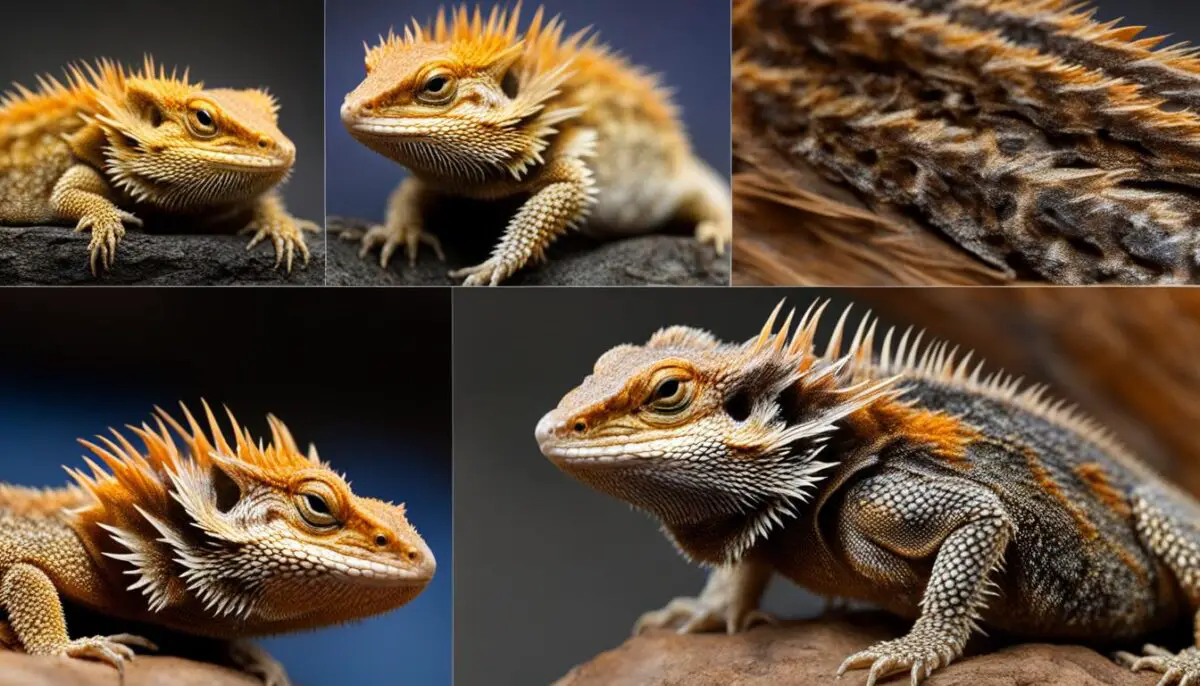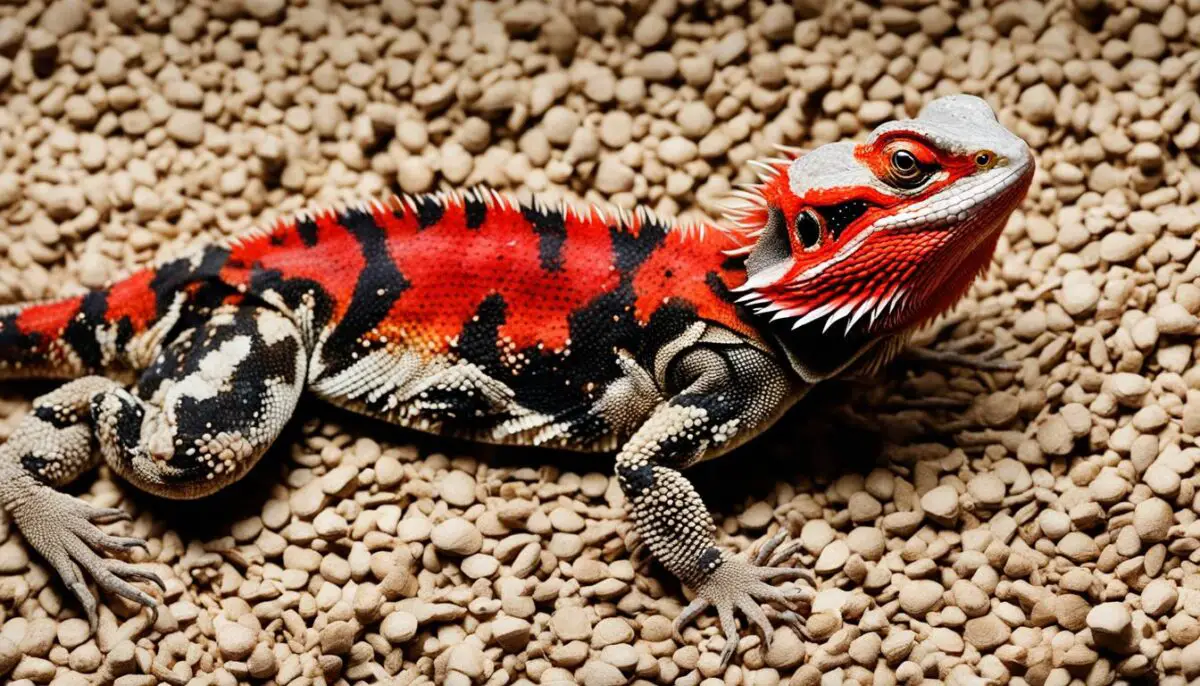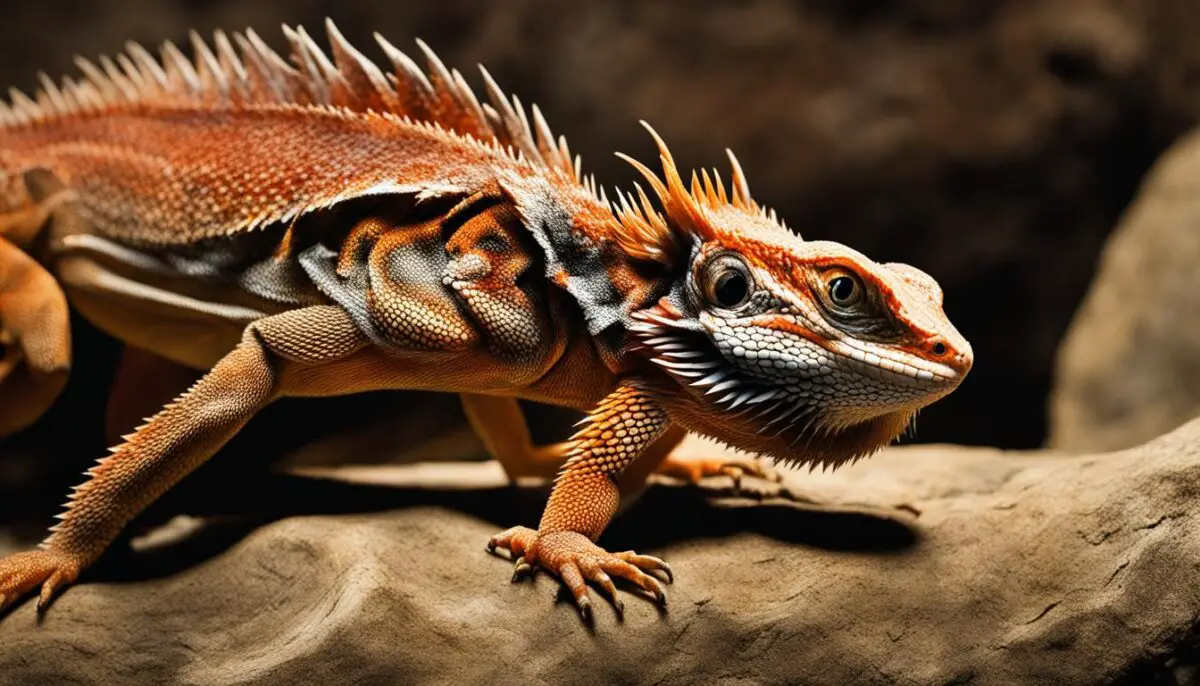As a reptile owner, dealing with mites on your bearded dragon can be a common and concerning issue. These tiny parasites latch onto your beardie and feed on its blood, potentially causing discomfort and severe health problems if left untreated. Identifying and treating mite infestations is crucial for the well-being of your bearded dragon.
Key Takeaways:
- Bearded dragon mites are parasitic insects that feed on the blood of your bearded dragon.
- Mites can carry harmful pathogens and bacteria, leading to health issues if not addressed promptly.
- There are different types of mites that can affect bearded dragons, including snake mites, chiggers, and storage mites.
- Identifying mite infestations and seeking proper treatment are essential for your bearded dragon’s health.
- Prevention measures, such as good hygiene and regular monitoring, can help reduce the risk of mite infestations.
What Are Bearded Dragon Mites?
Bearded dragon mites are a common problem that reptile owners may encounter. These tiny arachnids are external parasites that infest bearded dragons, feeding on their blood. Mites can cause discomfort and serious health issues if left untreated. It’s important to promptly identify and address these infestations to ensure the well-being of your bearded dragon.
Mites can be transmitted through various means, including direct contact with an infested reptile, purchasing an already-infected bearded dragon, or using contaminated supplies or decor. These parasites latch onto the beardie’s body and feed on their blood, causing irritation and potential distress.
To combat these mites, it’s crucial to understand their life cycle and behavior. Let’s take a closer look at the characteristics and nature of bearded dragon mites.
Bearded dragon mites are external parasites that infest bearded dragons and other reptiles. These arachnids attach themselves to the beardie’s body and feed on their blood, causing discomfort and potential health issues.
Did You Know? Mites are arachnids, belonging to the same family as spiders and ticks.
Bearded dragon mites can easily spread between reptiles through direct contact or exposure to infested environments. This includes purchasing a pre-infested bearded dragon or using contaminated supplies, such as substrate, hides, or decorations in your dragon’s enclosure.
Taking proactive measures to prevent bearded dragon mite infestations is essential. Regular examination of your pet, maintaining a hygienic environment, and ensuring proper quarantine for new acquisitions are crucial steps in safeguarding your bearded dragon from mites.

It’s important to closely examine your bearded dragon for any signs of mites. Check for these characteristic spots and clusters, particularly in skin folds and crevices. The grayish dust they leave behind can be another telltale sign of mite infestation.
| Signs of Bearded Dragon Mites | Description |
|---|---|
| Tiny black, red, or brown spots | Visible on the beardie’s body |
| Clusters of blackish-red spots | Commonly found in skin folds |
| Grayish dust | Left behind by mites, resembling waste |
Causes of Bearded Dragon Mite Infestations
Bearded dragon mites can find their way into your beloved pet’s habitat through various means. Understanding these causes is essential to prevent and address mite infestations effectively.
- Purchasing an already-infected bearded dragon: Unfortunately, some bearded dragons may already carry mites when purchased. It’s important to thoroughly inspect any potential additions to your reptile family and quarantine them before introducing them to your existing beardies.
- Handling infested reptiles: Direct contact with infested reptiles, whether at pet stores, reptile shows, or through interactions with other reptile owners, can quickly introduce mites into your dragon’s environment.
- Adding infested supplies and decor: Mites can hitch a ride on items such as logs, rocks, and plants that are brought into the enclosure. Always inspect and clean any new additions thoroughly before placing them in the habitat.
- Poor husbandry practices: Neglecting proper hygiene and regular cleaning can create an environment conducive to mite infestations. Lack of sanitation and inadequate maintenance can provide mites with the ideal conditions to thrive.
Addressing these underlying causes is vital to prevent future infestations and ensure the well-being of your bearded dragon.

Symptoms of Bearded Dragon Mites
It’s important for bearded dragon owners to be aware of the symptoms that may indicate a mite infestation. By recognizing these signs, you can take prompt action to address the issue and ensure the well-being of your beloved pet.
- Visible mites on the beardie’s body: Mites are often visible as tiny black, red, or brown spots on the skin. They may cluster in skin folds or leave behind a grayish dust on the beardie’s body.
- Dull or discolored skin: Infested bearded dragons may exhibit a lackluster appearance or changes in skin color.
- Bite marks and injuries: Mites can cause irritation and discomfort, leading to visible bite marks and injuries on the beardie’s skin.
- Behavioral changes: Lethargy, decreased appetite, and other behavioral changes may indicate the presence of mites.
- Itching and scratching: Bearded dragons infested with mites may scratch themselves frequently or exhibit signs of itching and discomfort.
- General sense of discomfort: If your bearded dragon seems restless or unsettled, it could be a sign of mite infestation.
It’s crucial to monitor your bearded dragon closely for these symptoms. If you notice any of these signs, seek veterinary care for proper diagnosis and treatment.

How to Get Rid of Mites on Bearded Dragons
Getting rid of mites on bearded dragons requires a multi-step process. First, it’s important to consult a veterinarian who can prescribe mite-killing medications. These medications are usually in liquid form and can be applied directly to the beardie or misted onto them. It’s also crucial to thoroughly clean the enclosure and surrounding area to eliminate any remaining mites and their eggs. Regular cleaning and hygiene practices can help prevent future mite infestations.
Here is a step-by-step guide to treating mites in bearded dragons:
- Consult a veterinarian: Seek professional advice from a reptile veterinarian experienced in treating mite infestations in bearded dragons. They can recommend the most appropriate medication and dosage for your beardie.
- Administer mite-killing medication: Follow the veterinarian’s instructions for applying the mite-killing medication. It’s essential to ensure thorough coverage of the infected areas.
- Clean the enclosure: Remove all items from the enclosure, including substrate, decor, and accessories. Wash these items thoroughly with hot, soapy water, rinsing well to eliminate any mites or eggs.
- Clean the enclosure thoroughly: Use a reptile-safe disinfectant to clean the enclosure itself, including the walls, floors, and any surfaces. Pay close attention to nooks and crannies where mites may hide.
- Let the enclosure dry: Allow the enclosure to air dry completely before reintroducing your bearded dragon. This step helps eliminate any remaining mites or their eggs.
- Quarantine or treat other reptiles: If you have multiple reptiles, particularly if they share the same living space, it’s important to quarantine or treat them for mites as well to prevent reinfestation.
- Monitor and maintain hygiene: After the initial treatment, closely monitor your bearded dragon for any signs of mites. Regularly clean the enclosure, wash hands before and after handling, and practice good husbandry to prevent future mite infestations.
Treating mites in bearded dragons requires patience and diligence. Proper veterinary care, thorough cleaning, and hygiene practices are key to successfully eliminating mites and preventing their return.
Testimonials from Bearded Dragon Owners:
“I followed my veterinarian’s advice and used the prescribed mite-killing medication. It took some time, but my bearded dragon is now mite-free and healthy again!” – Sarah K.
“Cleaning the enclosure was crucial in getting rid of mites. I washed everything thoroughly and made sure to let it dry completely before reintroducing my bearded dragon. Haven’t had a mite problem since!” – Mark T.
| Treatment Step | Effectiveness |
|---|---|
| Consulting a veterinarian | Highly effective |
| Administering mite-killing medication | Highly effective |
| Cleaning the enclosure | Highly effective |
| Quarantine or treat other reptiles | Essential for prevention |
Prevention of Bearded Dragon Mite Infestations
Preventing mite infestations in bearded dragons is crucial to ensure their well-being and minimize the risk of discomfort and health issues. By implementing a few simple practices, you can significantly reduce the chances of your bearded dragon experiencing a mite infestation.
Purchase from Reputable Sources
When acquiring a new bearded dragon, it’s essential to purchase from reputable sources. Make sure to research and choose a reputable breeder or pet store with a track record of healthy bearded dragons. Reputable sources prioritize the health and care of their reptiles, reducing the risk of mite infestations in the animals they sell.
Quarantine New Acquisitions
Before introducing a new bearded dragon to your existing reptile collection, it’s crucial to quarantine them. Separate the new acquisition from your current dragons for a period of at least 30 days. This quarantine period allows you to closely monitor the health of the new bearded dragon and prevent the potential spread of mites or other contagious diseases to your established dragons.
Practice Good Hygiene
When handling reptiles or visiting reptile environments, practicing good hygiene is vital. Wash your hands thoroughly with soap and water before and after handling your bearded dragon or any other reptiles. This helps minimize the risk of introducing mites or other pathogens into your dragon’s habitat.
Maintain Proper Husbandry and Cleaning Practices
Maintaining a clean and hygienic enclosure is essential for preventing mite infestations. Regularly clean and disinfect the habitat, including all decor, hides, and accessories. Remove any uneaten food or waste promptly to reduce the attraction of mites and other pests. Additionally, regularly inspecting your bearded dragon’s enclosure for signs of mites, such as black or red spots, can help detect infestations early and take prompt action.
Regular Monitoring and Observation
Keep a close eye on your bearded dragon’s health and behavior. Regularly observe them for any signs of distress, discomfort, or unusual behavior. Early detection of mite infestation can significantly improve the chances of successful treatment and prevent the spread of mites to other reptiles in your collection.
By following these preventive measures, you can create a healthy and mite-free environment for your bearded dragon. Remember, prevention is always better than cure when it comes to mite infestations.
Conclusion
Bearded dragon mites can be a troublesome issue for reptile owners, but with proper identification, treatment, and prevention, they can be managed effectively. Identifying the signs of mite infestations is crucial in order to take prompt action. If you notice the presence of mites on your bearded dragon or any signs of discomfort, it’s important to seek veterinary care immediately.
Treating mites in bearded dragons usually involves the use of mite-killing medications prescribed by a veterinarian. These medications can be applied directly to your beardie or misted onto them. It’s also essential to thoroughly clean the enclosure and surrounding areas to eliminate any remaining mites and their eggs.
Prevention plays a key role in keeping your bearded dragon mite-free. By practicing good hygiene, maintaining a clean environment, and regularly monitoring your beardie’s health, you can reduce the risk of mite infestations. Remember to purchase your bearded dragon from reputable sources and quarantine any new acquisitions before introducing them to your existing reptile collection.
FAQ
What are bearded dragon mites?
Bearded dragon mites are tiny parasitic insects that attach themselves to the beardie and feed on its blood. They can carry harmful pathogens and bacteria, potentially causing severe health problems if left untreated.
What do bearded dragon mites look like?
Bearded dragon mites appear as tiny black, red, or brown spots on the beardie’s body. They can cluster in skin folds, creating more visible areas of blackish-red. Mites may leave behind a grayish dust on the beardie’s body, which is their waste.
What are the causes of bearded dragon mite infestations?
Bearded dragon mite infestations can occur through direct contact with an infested reptile, purchasing an already-infected bearded dragon, or using infested supplies or decor. Poor husbandry practices can also lead to mite infestations.
What are the symptoms of bearded dragon mites?
Symptoms of mites in bearded dragons include visible mites on the beardie’s body, dull or discolored skin, bite marks and injuries, behavioral changes such as lethargy and appetite changes, itching and scratching, and a general sense of discomfort.
How can I get rid of mites on my bearded dragon?
It’s important to consult a veterinarian who can prescribe mite-killing medications. These medications are usually in liquid form and can be applied directly to the beardie or misted onto them. Thoroughly cleaning the enclosure and surrounding area is also crucial to eliminate any remaining mites and their eggs.
How can I prevent bearded dragon mite infestations?
Preventing mite infestations includes purchasing from reputable sources, quarantining new acquisitions, practicing good hygiene when handling reptiles or visiting reptile environments, and maintaining proper husbandry and cleaning practices.
How can I treat bearded dragon mite infestations?
Treating mites in bearded dragons involves consulting a veterinarian, who can prescribe mite-killing medications. Thoroughly cleaning the enclosure and surrounding area is also important to eliminate remaining mites and their eggs. Regular monitoring and observation of your bearded dragon’s health can help detect mite infestations early.
How do I identify bearded dragon mites?
Bearded dragon mites can be identified as tiny black, red, or brown spots on the beardie’s body. They may cluster in skin folds or leave a grayish dust on the beardie’s body.


